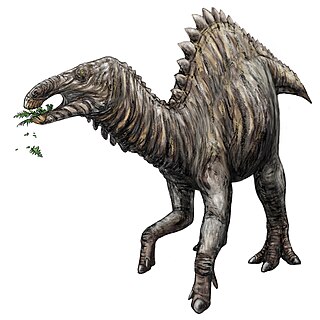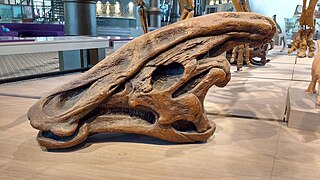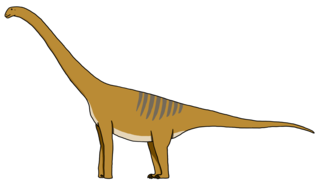Related Research Articles

Trachodon is a dubious genus of hadrosaurid dinosaur based on teeth from the Campanian-age Upper Cretaceous Judith River Formation of Montana, U.S. It is a historically important genus with a convoluted taxonomy that has been all but abandoned by modern dinosaur paleontologists.

Hadrosaurids, or duck-billed dinosaurs, are members of the ornithischian family Hadrosauridae. This group is known as the duck-billed dinosaurs for the flat duck-bill appearance of the bones in their snouts. The ornithopod family, which includes genera such as Edmontosaurus and Parasaurolophus, was a common group of herbivores during the Late Cretaceous Period. Hadrosaurids are descendants of the Late Jurassic/Early Cretaceous iguanodontian dinosaurs and had a similar body layout. Hadrosaurs were among the most dominant herbivores during the Late Cretaceous in Asia and North America, and during the close of the Cretaceous several lineages dispersed into Europe, Africa, and South America.

Baron Franz Nopcsa von Felső-Szilvás was a Hungarian aristocrat, adventurer, scholar, geologist, paleontologist and albanologist. He is widely regarded as one of the founders of paleobiology, and first described the theory of insular dwarfism. He was also a specialist on Albanian studies and completed the first geological map of northern Albania.

Antarctosaurus is a genus of titanosaurian sauropod dinosaur from the Late Cretaceous Period of what is now South America. The type species, Antarctosaurus wichmannianus, and a second species, Antarctosaurus giganteus, were described by prolific German paleontologist Friedrich von Huene in 1929. Three additional species of Antarctosaurus have been named since then but later studies have considered them dubious or unlikely to pertain to the genus.

Saurolophus is a genus of large hadrosaurid dinosaur from the Late Cretaceous period of Asia and North America, that lived in what is now the Horseshoe Canyon and Nemegt formations about 70 million to 66 million years ago. It is one of the few genera of dinosaurs known from multiple continents. The type species, S. osborni, was described by Barnum Brown in 1912 from Canadian fossils. A second valid species, S. angustirostris, is represented by numerous specimens from Mongolia, and was described by Anatoly Konstantinovich Rozhdestvensky.

Chilantaisaurus is a genus of large theropod dinosaur, possibly a neovenatorid or a primitive coelurosaur, from the Late Cretaceous Ulansuhai Formation of China. The type species, C. tashuikouensis, was described by Hu in 1964.

Jaxartosaurus is a genus of hadrosaurid dinosaur similar to Corythosaurus which lived during the Late Cretaceous. Its fossils were found in Kazakhstan.

Tanius is a genus of hadrosauroid dinosaur. It lived in the Late Cretaceous of China. The type species, named and described in 1929 by Carl Wiman, is Tanius sinensis. The generic name honours the Chinese paleontologist Tan Xichou. The specific epithet refers to China. In 2010 Gregory S. Paul estimated the length of Tanius at 7 metres (23 ft) and its weight at 2 metric tons.

Charonosaurus is a genus of dinosaur whose fossils were discovered by Godefroit, Zan & Jin in 2000, on the south bank of the Amur River, dividing China from Russia. It is monotypic, consisting of the species C. jiayinensis.

Cionodon is a dubious genus of hadrosaurid dinosaur from the Late Cretaceous. The type species, C. arctatus, was found in the Denver Formation of Lodge Pole Creek, Colorado and was formally described by Edward Drinker Cope in 1874 based on the holotype AMNH 3951, collected in 1873. It is a nomen dubium because it is based on very fragmentary remains. Two other species have since been described: Cionodon kysylkumensis, based on the holotype CCMGE 1/3760 from Uzbekistan, and Cionodon stenopsis, discovered in rocks from the Judith River Formation of Alberta, Canada in 1874. Although both are probably hadrosaurs, they are known only from fragmentary remains and Cionodon kysylkumensis has since been reclassified as Bactrosaurus kysylkumensis.

Embasaurus is a genus of theropod dinosaur from the Early Cretaceous period. It is known from two vertebrae found in the Neocomian Sands of Kazakhstan. As it is known only from fragmentary remains, Embasaurus is considered by some to be a possible nomen dubium. It was named after the Emba River, and it is believed to have lived during the Berriasian stage, around 140 million years ago. According to the Theropod Database, a personal website designed by Mickey Mortimer, further research may suggest that Embasaurus may be a basal tyrannosauroid. George Olshevsky, however, considered Embasaurus to be a megalosaurid, closely related to Magnosaurus, Megalosaurus, and Torvosaurus.

Mandschurosaurus is an extinct genus of hadrosaurids based on material from the Late Cretaceous of China and possibly also the Early Cretaceous of Laos. It was the first dinosaur genus named from China.

Kerberosaurus was a genus of saurolophine duckbill dinosaur from the late Maastrichtian-age Upper Cretaceous Tsagayan Formation of Blagoveshchensk, Amur Region, Russia. It is based on bonebed material including skull remains indicating that it was related to Saurolophus and Prosaurolophus.

Orthomerus is a genus of dubious hadrosaurid dinosaur from the Late Cretaceous of the Netherlands. It is today an obscure genus, but in the past was conflated with the much better known Telmatosaurus.

The Lost World is a 1995 science fiction action novel written by Michael Crichton, and the sequel to his 1990 novel Jurassic Park. It is his tenth novel under his own name and his twentieth overall, and it was published by Knopf. A paperback edition (ISBN 0-345-40288-X) followed in 1996. In 1997, both novels were re-published as a single book titled Michael Crichton's Jurassic World, which is unrelated to the 2015 film of the same name.

Arkharavia is a dubious genus of somphospondylan sauropod, but at least some of the remains probably belong to a hadrosaurid. It was discovered in the Udurchukan Formation in Russia and lived during the Late Cretaceous. It was described in 2010 by Alifanov and Bolotsky and the type species is A. heterocoelica.

Ankylopollexia is an extinct clade of ornithischian dinosaurs that lived from the Late Jurassic to the Late Cretaceous. It is a derived clade of iguanodontian ornithopods and contains the subgroup Styracosterna. The name stems from the Greek word, “ankylos”, mistakenly taken to mean stiff, fused, and the Latin word, “pollex”, meaning thumb. Originally described in 1986 by Sereno, a most likely synapomorphic feature of a conical thumb spine defines the clade.

Kazaklambia is an extinct genus of herbivorous lambeosaurine dinosaur known from the Late Cretaceous Dabrazinskaya Svita of southern Kazakhstan. It contains a single species, Kazaklambia convincens.
Riabininohadros is an extinct genus of ankylopollexian dinosaur from the Maastrichtian of Crimea. Its type species is Riabininohadros weberi, emended to Riabininohadros weberae. It was originally classified as a species of Orthomerus, until 2015.

This timeline of hadrosaur research is a chronological listing of events in the history of paleontology focused on the hadrosauroids, a group of herbivorous ornithopod dinosaurs popularly known as the duck-billed dinosaurs. Scientific research on hadrosaurs began in the 1850s, when Joseph Leidy described the genera Thespesius and Trachodon based on scrappy fossils discovered in the western United States. Just two years later he published a description of the much better-preserved remains of an animal from New Jersey that he named Hadrosaurus.
References
- ↑ "AMUROSAURUS DinoChecker" . Retrieved 24 September 2017.
- ↑ "Researchgate" . Retrieved 24 September 2017. pg. 387
- ↑ Eberth, David (2015). Hadrosaurs. Indiana University Press. p. 295. ISBN 9780253013859.
- ↑ "Pteros" . Retrieved 27 September 2017.